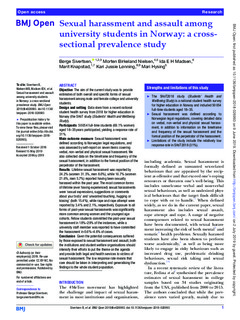| dc.contributor.author | Sivertsen, Børge | |
| dc.contributor.author | Nielsen, Morten Birkeland | |
| dc.contributor.author | Madsen, Ida E.H. | |
| dc.contributor.author | Knapstad, Marit | |
| dc.contributor.author | Lønning, Kari Jussi | |
| dc.contributor.author | Hysing, Mari | |
| dc.date.accessioned | 2019-08-09T11:14:09Z | |
| dc.date.available | 2019-08-09T11:14:09Z | |
| dc.date.created | 2019-06-11T12:57:43Z | |
| dc.date.issued | 2019 | |
| dc.identifier.issn | 2044-6055 | |
| dc.identifier.uri | http://hdl.handle.net/11250/2607765 | |
| dc.description.abstract | Objective The aim of the current study was to provide estimates of both overall and specific forms of sexual harassment among male and female college and university students.
Design and setting Data stem from a recent national student health survey from 2018 for higher education in Norway (the SHoT study (Students’ Health and Wellbeing Study)).
Participants 50 054 full-time students (69.1% women) aged 18–35 years participated, yielding a response rate of 31%.
Main outcome measure Sexual harassment was defined according to Norwegian legal regulations, and was assessed by self-report on seven items covering verbal, non-verbal and physical sexual harassment. We also collected data on the timeframe and frequency of the sexual harassment, in addition to the formal position of the perpetrator of the harassment.
Results Lifetime sexual harassment was reported by 24.2% (women 31.3%, men 8.0%), while 16.7% (women 21.6%, men 5.7%) reported having been sexually harassed within the past year. The most common forms of lifetime (ever having experienced) sexual harassments were ‘sexual expressions, suggestions or comments about your body’ and ‘unwanted touching, hugging or kissing’ (both 15.4%), while rape and rape attempt were reported by 3.4% and 2.1%, respectively. Exposure to all forms of past-year sexual harassments was significantly more common among women and the youngest age cohorts. Fellow students committed the past-year sexual harassment in 18%–29% of the instances, while a university staff member was reported to have committed the harassment in 0.6%–4.6% of cases.
Conclusion Given the potential consequences suffered by those exposed to sexual harassment and assault, both the institutions and student welfare organisations should intensify their efforts to put the theme on the agenda and provide both legal and health services to victims of sexual harassment. The low response rate means that care should be taken in interpreting and generalising the findings to the whole student population. | nb_NO |
| dc.language.iso | eng | nb_NO |
| dc.publisher | BMJ Publishing Group | nb_NO |
| dc.rights | Navngivelse 4.0 Internasjonal | * |
| dc.rights | Navngivelse-Ikkekommersiell 4.0 Internasjonal | * |
| dc.rights.uri | http://creativecommons.org/licenses/by-nc/4.0/deed.no | * |
| dc.title | Sexual harassment and assault among university students in Norway: A cross-sectional prevalence study | nb_NO |
| dc.type | Journal article | nb_NO |
| dc.type | Peer reviewed | nb_NO |
| dc.description.version | publishedVersion | nb_NO |
| dc.source.volume | 9 | nb_NO |
| dc.source.journal | BMJ Open | nb_NO |
| dc.identifier.doi | 10.1136/bmjopen-2018-026993 | |
| dc.identifier.cristin | 1703984 | |
| dc.description.localcode | © Author(s) (or their employer(s)) 2019. Re-use permitted under CC BY-NC. No commercial re-use. See rights and permissions. Published by BMJ. | nb_NO |
| cristin.unitcode | 194,65,35,0 | |
| cristin.unitname | Institutt for psykisk helse | |
| cristin.ispublished | true | |
| cristin.fulltext | original | |
| cristin.qualitycode | 1 | |

